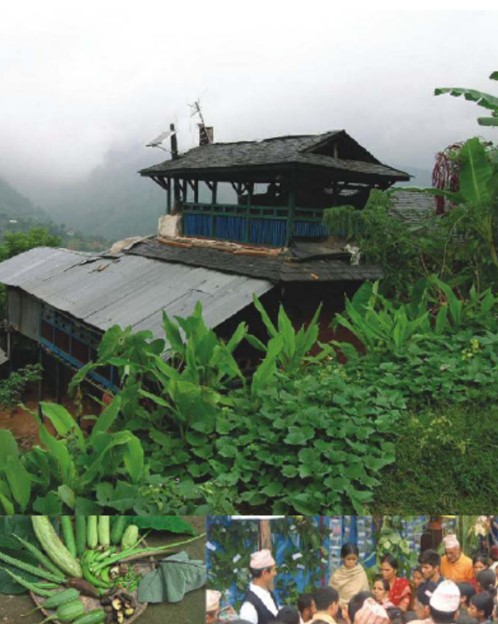Home Gardens in Nepal

Home Gardens in Nepal

Home Gardens in Nepal – The Value of Home Gardens to Small farmers. The home garden is a traditional component of the rural ecosystem that has been practiced for a long time by farmers.
Home gardens are often overlooked as an important source of food and nutrition at national level. For subsistence and poor farmers, crop varieties and cultivars adapted to particular micro-niches around homesteads are crucial and accessible resources available to provide a secure livelihood.
The purpose of this paper is to review the value of home gardens that contribute to not only food and nutrition but also a wide range of social, economic and environmental benefits to people.
The paper also describes the goods and services provided by agricultural biodiversity in home gardens that interface between the natural ecosystem, orchards and crop fields.
The paper suggests that the home garden could be an entry point to empower the community to manage on-farm agricultural biodiversity while promoting dietary diversity for healthier families and ecosystems.
A home garden is a micro-environment composed of a multi-species (annual to perennial, root crops to climbers etc.), multi-storied and multi-purpose garden situated close to the homestead (Quat, NX, 1996; Watson and Eyzaguirre, 2002; Hodgkin, 2002).
A home garden refers to the traditional land use system around a homestead, where several species of plants are grown and maintained by the household members and their products are primarily intended for the family consumption.
Several terms have been used to describe these garden production systems, such as “homestead garden, backyard garden, kitchen garden, agro forestry, mixed garden, garden culture, etc.” (Helen Keller International, 2001; Mictchell and Hanstad, 2004).
‘The term “home garden” is preferred because it stresses the close relationship between the garden and the social group residing at home. The home garden provides a bridge between the social and biological, linking cultivated species and natural ecosystems, combining, and conserving species diversity and genetic diversity (Eyzaguirre and Linares, 2004).
The importance of home gardens is evident across countries and societies. Different cultures and customs have different names for this homestead production system, for example, Conuco in Cuba and Venezuela (Castineiras et al., 2000; Mula’s et al., 2004), Vuon nha in Vietnam (Trinh et al., 2003), Peka Rangan in Indonesia (Abdoellah et al.,2003).
Those millions of households throughout the world that keep their biodiversity close at hand, that use it daily for multiple purposes, that imbue it with cultural and spiritual value, are
providing a lesson to all humanity on the importance and value of biodiversity. For this reason alone, Eyzaguirre and Linares (2004) voiced that home gardens are to be celebrated, supported and conserved.
The Nepalese context
The home garden, literally known in Nepali as Ghar Bagaincha, refers to the traditional land use system around a homestead, where several species of plants are grown and maintained by household members and their products are primarily intended for the family consumption Figure 1, (Shrestha et al., 2002).
The term “home garden” is often considered synonymous to the kitchen garden. However, they differ in terms of function, size, diversity, composition and features (Table 1).
In Nepal, 72% of households have home gardens of an area 2-11%of the total land holdings (Gautam et al., 2004). Because of their small size, the government has never identified home gardens as an important unit of food production, and it thereby remains neglected from research and development.
Traditionally home gardens are an important source of quality food and nutrition for the rural poor and, therefore, are important contributors to the food security and livelihoods of farming communities in Nepal.
They are typically cultivated with a mixture of annual and perennial plants that can be harvested on a daily or seasonal basis. Biodiversity that has an immediate value is maintained in home gardens as women and children have easy access to preferred food, and for this reason alone we should promote home gardens as a key element for a healthy way of life.
Home gardens, with their intensive and multiple uses, provide a safety net for households when food is scarce. These gardens are not only important sources of food, fodder, fuel, medicines, spices, herbs, flowers, construction materials and income in many countries, they are also important for the in-situ conservation of a wide range of unique genetic resources for food and agriculture (Subedi et al., 2004).
Many uncultivated, as well as neglected and underutilized species could make an important contribution to the dietary diversity of local communities (Gautam et al., 2004). Nepalese home gardens are dynamic in their evolution, composition and uses.
Their structure, functions, and both inter- and intra-specific genetic diversity, have been influenced by changes in socioeconomic circumstances and the cultural values of users of these gardens. Furthermore, farmers often use home gardens as a site for the experimentation, introduction and domestication of plants (Shrestha et al., 2002; Eyzaguirre and Linares, 2004). Typically, home gardens are valued for the following specific uses (Shrestha et al., 2002):
• Food security, nutrition and a cash income
• Fodder, firewood and timber
• Spices, herbs and medicinal plants
• Green manures and pesticide crops
• Cultural and religious uses
Home gardens also constitute a valuable part of the in situ conservation method, but their importance for genetic resources conservation is still not widely recognized. Home gardens are common in many rural areas of Nepal.
They usually have a well-defined structure with fodder and fruit trees predominant at the periphery of homestead. Moving inwards, the canopy is progressively reduced by planting vegetable and arable crops. Gautam et al., (2005) reported that there are many key species that are found only in home garden, and they are interconnected by informal germplasm exchanges.
Reasons for the rich diversity of species in home gardens
Home gardens, one of the oldest forms of managed land-use systems, are considered to be the richest in species diversity per unit area. Several landraces and cultivars, and rare and endangered species have been preserved in the home gardens (Watson and Eyzaguirre, 2002; Kumar and Nair, 2004).
However, species richness of home gardens within a region is influenced by homestead size, structure, climatic conditions, market and socio-cultural forces.
In the wetter parts of the middle hill areas of Nepal (e.g. Illam), more than 75% of home gardens have 21 to 50 diverse species per household, whereas the drier conditions of Gulmi nurture 11-40 species (Gautam et al., 2004)1.
In Nepalese home gardens, richness of home garden species can be seen in the following order: vegetable, fruits, spices, fodder,
medicinal, ornamental and other species (Subedi et al., 2004).
Besides direct use values, farmers maintain local crop diversity in home gardens for the following reasons:
1) To meet the specific needs of local ethnic food culture
2) To increase the options of availability of fresh leafy vegetables, herbs, spices, fruits etc., at the household level
3) For easy access to fresh food as refrigerators are an uncommon option for preservation
4) To save money by reducing expenses on daily needs, especially condiments
5) To improve self-reliance, as access to markets is difficult in remote areas
6) To improve access to low-cost sources of vitamins and minerals
7) To increase the variety of vegetables, fruits, etc. to ensure a healthy, functional level of nutrition (e.g. antioxidants, carotenoids, phenolics, dietary fibers and foods with low glycemic index) (Sthapit et al., 2004).
READ MUCH MORE INSIDE…
DOWNLOAD YOUR COPY NOW 135 Pages $37

Click the Purchase Button Below to Get Instant Access.
[wpforms id=”61″]
Your Name and Email will Never Be Shared or Given to Anyone.
Warmest Regards,
Coyalita Linville
Copyright © 2023 – 2024 Sunrise-Sunset-Nature-Gardens.com. All Rights Reserved Privacy Policy – Earning Disclaimer – Terms of Use – Contact Us





